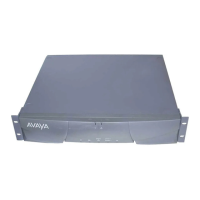Maintenance-Object Repair Procedures
555-233-143
8-950 Issue 1 May 2002
IPSV-CTL (Ipserver Interface Control)
The TN2312AP IPSI circuit packs are duplicated in a high- or critical-reliability
system. As part of duplicated IPSIs, PKTINTs, Archangels, and Tone-Clocks are
also duplicated. However, to simplify recovery algorithms, only one IPSI can be
“active” in a given PN. (The one exception to this rule is the IPSI’s tone-detection
module. Both IPSIs may have active tone detectors.) During an IPSI
interchange, their PKTINTs, Archangels, and Tone-Clocks can be distributed
between the two IPSIs. But during stable operation, the active PKT-INT,
Archangel, and Tone-Clock must all reside on the same IPSI.
Each IPSI’s state of health (SOH) with the following elements in descending order
of priority:
■ Tone-Clock
■ PKT-INT
■ Archangel
The active media server’s maintenance software is responsible for maintaining
the SOH of both IPSIs (active and standby) in each PN. If an active IPSI’s SOH is
lower than the standby’s, IPSI interchange is initiated. The following list contains
failures/actions that would result in the interchange:
■ Active IPSI has a faulty Tone-Clock.
1. IPSI’s hardware detects loss of clock, and its firmware initiates clock
interchange.
2. IPSI’s firmware notifies software of loss of clock.
3. Software interchanges PKT-INT.
4. Software interchanges Archangel.
■ Active IPSI has a faulty PKT-INT.
1. Software detects faulty PKT-INT.
2. Software interchanges PKT-INT.
3. Software interchanges Archangel.
4. Software interchanges Tone-Clock.
Table 8-369.
MO’s Name
(in Alarm
Log) Alarm Level
Initial SAT Command to
Run Full Name of MO
IPSV-CTL NA set ipserver-interface Ipserver Interface Control

